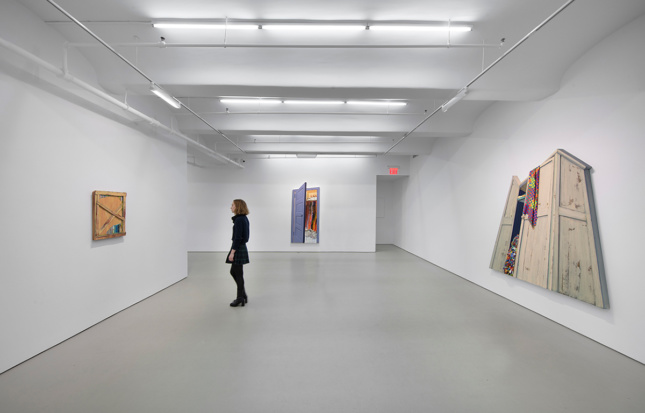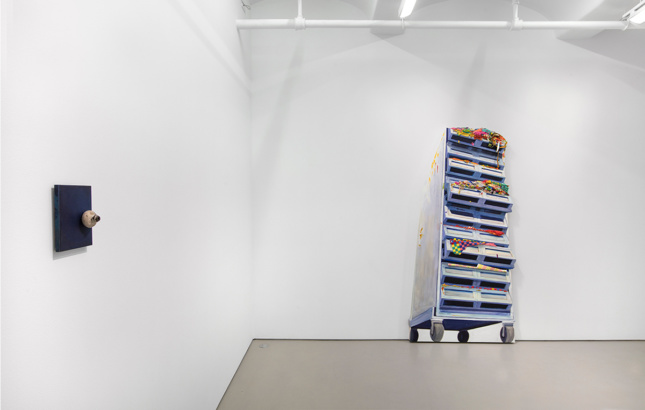A new exhibition by New York–based artist Leslie Wayne explores everyday spaces and how, through alternative modes of representation, we can see those environments in a deeper light. What’s Inside, now on view at New York City’s Jack Shainman Gallery through March 30, features Wayne’s newest collection of paintings that detail basic domestic scenes like messy closets, busy bookshelves, and broken windows. These disheveled objects evoke a German Expressionist perspective, according to the artist, and unveil Wayne’s political and personal anxieties through singular depictions of an inner world that’s “not quite right,” but can be fixed.
AN spoke with Wayne via email about the layered inspiration behind What’s Inside, and how color, both in architecture and in painting, can manipulate the emotions of its viewers. She also explains why studying art that highlights buildings or interior design can ultimately strengthen a person’s appreciation for the built environment.
The Architect’s Newspaper: Your current collection seems to build off your previous window pieces for Free Experience. Can you explain why you decided to continue that project and how this show takes those previous themes to another level?
Leslie Wayne: As an abstract artist, my whole career, I’ve been wanting to bring representation into my work, but I didn’t quite know how it would manifest itself given the idiosyncratic way I use paint. Those first window paintings gave me a way to do that. Conceptually, they allowed me to express my feelings and ideas about the world around me, about the current state of affairs, as well as my own personal life, by using domestic architectural forms as a motif and as a kind of organizing principle. I realized that my abstract paintings always kept you on a threshold—of what was visible, and what was beneath and behind the surface that you could never quite completely see or understand. Architectural thresholds can operate in much the same way. By making a painting of a doorway that is just barely cracked open, or a window that is boarded up, I’m keeping you on that threshold. So actually, I’m still exploring the same thing, only in a more pictorial way.

AN: Why did you choose to focus on normal interior objects and spaces? What draws you to imagining these details in a new way?
LW: I’m drawing largely on my immediate surroundings—the armoire in my bedroom, the tool chest in my husband’s studio, and my bookshelves. While the forms as furniture are universal, their contents are autobiographical, and they tell you a lot about what makes up my life. In the beginning, the idea of creating a painting of a closet was just a response to my need to move on from an earlier body of work. But then the idea of closets became more interesting to me as types of containers. Containers, not just of clothing and everyday objects, but of things we hold dear, or secrets we want to keep. And then came the paintings of drawers and bookshelves, containers that hold evidence of your life—books you’ve read, music you listen to, materials you use for work, etc. And on a purely formal level, closets, shelves, and window frames provide an interesting platform for different kinds of architectural motifs, which as a painter is great because it’s just an endless source of visual information.

AN: Your work is very colorful and tactile. What do the different colors and the way those hues bring a tangible quality to your paintings say about these mundane architectural spaces you depict?
LW: Color is loaded with emotive power, much the same way that music is. It can be used to express tremendously strong feelings, but, because of that, you’re in danger of being manipulative and clichéd if you go too far. It’s tricky. You want to seduce the viewer but not knock them over the head with it! Most people, when they’re thinking about architecture they’re thinking about the facade and the overall shape of a building or an architectural detail. They’re not considering the way in which a building is a container and a shelter and how the design and the color of an interior space can determine the way you feel when you go inside of it.
We were in Mexico City recently and went to the house of Luis Barragán. It was very interesting to see how he used color to visually block out certain spaces and establish an overall feeling of a room. Yellow walls made you feel warm and welcomed, pink walls gave you a sensation of joy and anticipation. I loved that. For me, when I’m painting, I try to use color to do much the same thing, to convey a sensation.

AN: Why is it valuable to look at architecture and interiors through the alternative lenses of painting or photography, rather than being in the space itself?
LW: I would say that it’s valuable to look at architecture and interiors through the alternative lenses of painting or photography in addition to being in the space itself. There’s no substitute for having a direct experience of an architectural space. But I think we take those spaces for granted. And those of us in dense urban environments usually have our heads down (or buried in our cell phones!) when we’re walking rather than looking up and noticing what tremendously rich details are on buildings all around us. It’s valuable to reconsider what those spaces mean to us and art can take you there through the poetry of metaphor and illusion. If you’ve ever been taken by a Fra Angelico painting for example, like The Annunciation, then perhaps next time you’re inside a space that has vaulted ceilings you’ll be reminded of the painting and become aware of the ceiling’s elegance and structural integrity. Or a Dorothea Lange photograph of a young sharecropper’s log cabin can make you really feel what it must mean to live in a structure of such simplicity. Bernd and Hilla Becher spent their lives documenting industrial architecture and brought the simplest most overlooked structures, like water towers, into the realm of the sublime. We look at these things every day, but art helps us see them more deeply.
See Wayne’s new show, What’s Inside, at the Jack Shainman Gallery at 513 West 20th Street, New York, New York.











